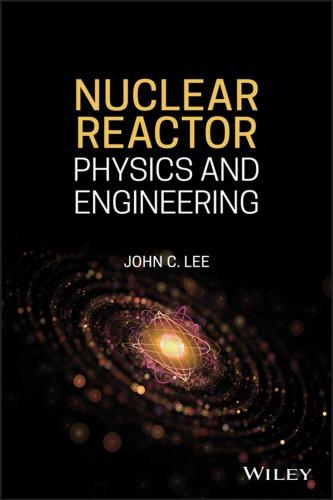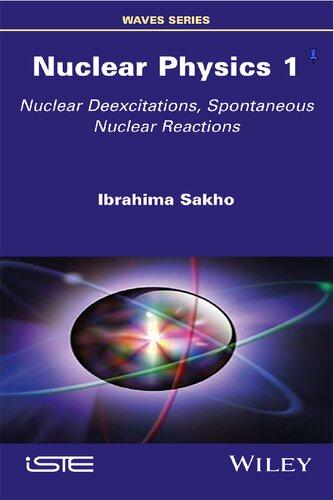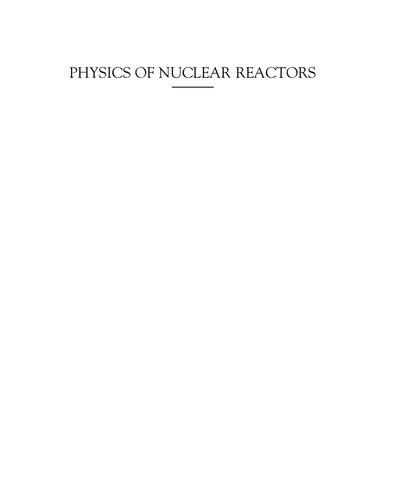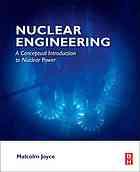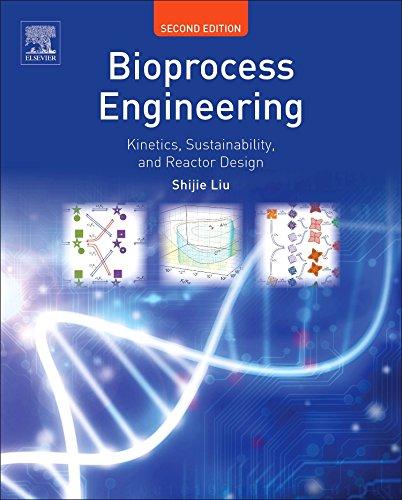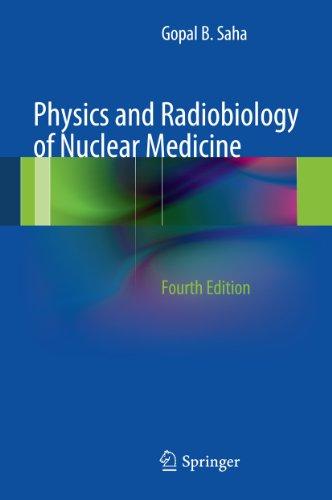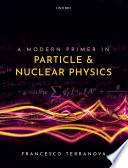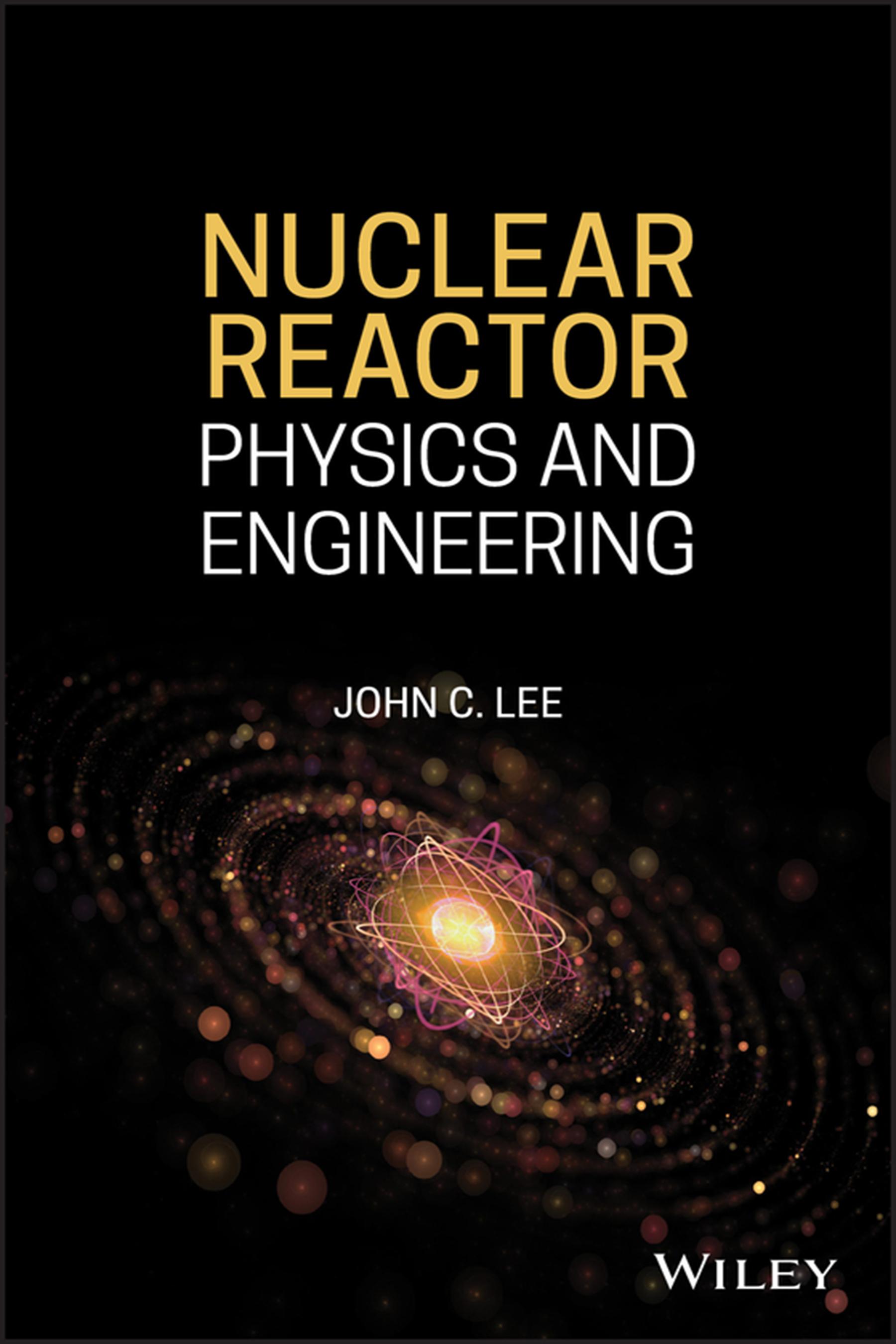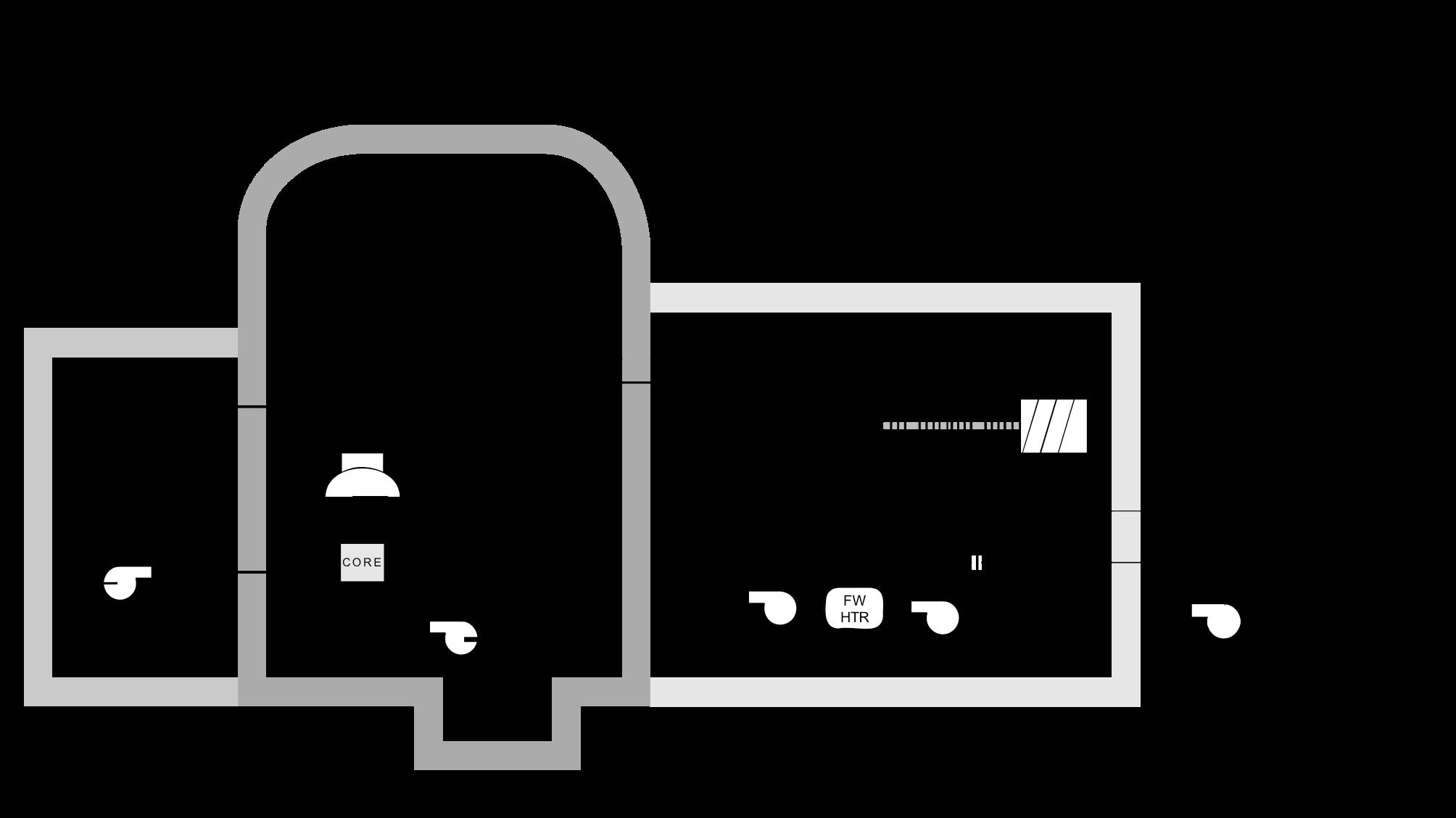Nuclear reactor physics and engineering Lee
Visit to download the full and correct content document: https://ebookmass.com/product/nuclear-reactor-physics-and-engineering-lee/
More products digital (pdf, epub, mobi) instant download maybe you interests ...
Nuclear Reactor Physics and Engineering John C. Lee
https://ebookmass.com/product/nuclear-reactor-physics-andengineering-john-c-lee/
Nuclear Physics 1: Nuclear Deexcitations, Spontaneous Nuclear Reactions Ibrahima Sakho
https://ebookmass.com/product/nuclear-physics-1-nucleardeexcitations-spontaneous-nuclear-reactions-ibrahima-sakho/
Physics of nuclear reactors K. Umasankari
https://ebookmass.com/product/physics-of-nuclear-reactors-kumasankari/
Nuclear engineering : a conceptual introduction to nuclear power Joyce
https://ebookmass.com/product/nuclear-engineering-a-conceptualintroduction-to-nuclear-power-joyce/
Bioprocess Engineering. Kinetics, Sustainability, and Reactor Design 2nd
Edition Shijie Liu
https://ebookmass.com/product/bioprocess-engineering-kineticssustainability-and-reactor-design-2nd-edition-shijie-liu/
Bioprocess Engineering: Kinetics, Sustainability, and Reactor Design 3rd Edition Shijie Liu
https://ebookmass.com/product/bioprocess-engineering-kineticssustainability-and-reactor-design-3rd-edition-shijie-liu/
Fundamentals of Nuclear Science and Engineering 3rd Edition
https://ebookmass.com/product/fundamentals-of-nuclear-scienceand-engineering-3rd-edition/
Physics and Radiobiology of Nuclear Medicine 4th Edition, (Ebook PDF)
https://ebookmass.com/product/physics-and-radiobiology-ofnuclear-medicine-4th-edition-ebook-pdf/
A Modern Primer in Particle and Nuclear Physics
Francesco Terranova
https://ebookmass.com/product/a-modern-primer-in-particle-andnuclear-physics-francesco-terranova/
NUCLEARREACTOR PHYSICSAND ENGINEERING
NUCLEARREACTOR PHYSICSAND ENGINEERING
JohnC.Lee
UniversityofMichigan
AnnArbor,Michigan
This edition first published 2020 © 2020JohnWiley&Sons,Inc.
Allrightsreserved.Nopartofthispublicationmaybereproduced,storedinaretrievalsystem,ortransmitted,inany formorbyanymeans,electronic,mechanical,photocopying,recordingorotherwise,exceptaspermittedbylaw.Advice onhowtoobtainpermissiontoreusematerialfromthistitleisavailableathttp://www.wiley.com/go/permissions.
TherightofJohnC.Leetobeidentifiedastheauthorofthisworkhasbeenassertedinaccordancewithlaw.
RegisteredOffice
JohnWiley&Sons,Inc.,111RiverStreet,Hoboken,NJ07030,USA
EditorialOffice
111RiverStreet,Hoboken,NJ07030,USA
Fordetailsofourglobaleditorialoffices,customerservices,andmoreinformationaboutWileyproductsvisitusat www.wiley.com.
Wileyalsopublishesitsbooksinavarietyofelectronicformatsandbyprint-on-demand.Somecontentthatappearsin standardprintversionsofthisbookmaynotbeavailableinotherformats.
LimitofLiability/DisclaimerofWarranty
Whilethepublisherandauthorshaveusedtheirbesteffortsinpreparingthiswork,theymakenorepresentationsor warrantieswithrespecttotheaccuracyorcompletenessofthecontentsofthisworkandspecificallydisclaimall warranties,includingwithoutlimitationanyimpliedwarrantiesofmerchantabilityorfitnessforaparticularpurpose.No warrantymaybecreatedorextendedbysalesrepresentatives,writtensalesmaterialsorpromotionalstatementsforthis work.Thefactthatanorganization,website,orproductisreferredtointhisworkasacitationand/orpotentialsourceof furtherinformationdoesnotmeanthatthepublisherandauthorsendorsetheinformationorservicestheorganization, website,orproductmayprovideorrecommendationsitmaymake.Thisworkissoldwiththeunderstandingthatthe publisherisnotengagedinrenderingprofessionalservices.Theadviceandstrategiescontainedhereinmaynotbe suitableforyoursituation.Youshouldconsultwithaspecialistwhereappropriate.Further,readersshouldbeawarethat websiteslistedinthisworkmayhavechangedordisappearedbetweenwhenthisworkwaswrittenandwhenitisread. Neitherthepublishernorauthorsshallbeliableforanylossofprofitoranyothercommercialdamages,includingbut notlimitedtospecial,incidental,consequential,orotherdamages.
LibraryofCongressCataloging-in-PublicationData()
ISBN: 9781119582328
CoverdesignbyWiley
Coverimage: © LanaPo/Shutterstock
Setin9/11pt,NimbusRomNo9LbySPiGlobal,Chennai,India.
PrintedintheUnitedStatesofAmerica
10987654321 applied for
Prefacexiv
1.1HistoryandCurrentStatusofNuclearPowerPlants........2
1.2BasicFeaturesofNuclearPowerPlants..............3
1.3PressurizedWaterReactorSystems................5
1.4BoilingWaterReactorSystems..................11
1.5AdvancedReactorDesigns.....................17
2Neutron-nucleusReactionandNeutronCrossSection
2.1Neutron-nucleusReactionProbabilityandNeutronCrossSection28
2.2MechanismsofNeutron-nucleusInteraction............29
2.3NuclearFissionProcess......................32
2.4Two-bodyCollisionMechanicsandCenter-of-massSystem...37
2.5Single-LevelBreit-WignerFormulaforResonanceReaction...42
2.6DifferentialScatteringCrossSectionandScatteringKernel....45
2.6.1DifferentialMicroscopicScatteringCrossSection....46
2.6.2ScatteringKernelforIsotropicScatteringinCMFrame.47
2.7FurtherRemarksonNeutronCrossSection............49 References.................................54 Problems.................................55
3NeutronFlux,ReactionRate,andEffectiveCrossSection 59
3.1NeutronFluxandCurrent.....................60
3.2RateofNeutron-NucleusInteraction................66
3.3NeutronEnergyDistributionandEffectiveThermalCrossSection69 3.4Applicationtoa 1/v-Absorber...................73 References.................................74 Problems.................................74
4DerivationoftheNeutronDiffusionEquation 77
4.1BasicAssumptionsforNeutronBalanceStatement........78
4.2NeutronBalanceEquation.....................79
4.3NeutronSourceTerm........................83
4.4Fick’sLawofNeutronCurrent...................84
4.5NeutronTransportEquationand P1 Approximation........88
4.6RemarksonDiffusionCoefficient.................92
4.7LimitationsofNeutronDiffusionTheory.............94
4.8One-GroupNeutronDiffusionEquation..............94
4.9SummaryDiscussionofDiffusionEquation............96 References.................................96 Problems.................................97
5ApplicationsoftheOne-GroupNeutronDiffusionEquation99
5.1BoundaryConditionsforDiffusionEquation...........100
5.2SolutionofSteady-StateDiffusionEquation............104
5.2.1FluxinNon-multiplyingMediawithLocalizedSources.104
5.2.2FluxinNon-multiplyingMediawithDistributedSources112
5.3NeutronFluxinMultiplyingMediumandCriticalityCondition.115
5.3.1CriticalityandBuckling..................116
5.3.2EffectiveMultiplicationFactor..............117
5.3.3EigenfunctionsofDiffusionEquationandBuckling...119
5.4Four-andSix-FactorFormulasforMultiplicationFactor.....124
5.5ConcludingRemarks........................126 References.................................126
6NumericalSolutionoftheNeutronDiffusionEquation 131
6.1FiniteDifferenceFormofDiffusionEquation...........132
6.2FluxSolutionAlgorithm:InnerIteration.............136
6.3BoundaryConditionsforDifferenceEquation...........138
6.4SourceorOuterIteration......................140
6.5RelativePowerDistributionandOverallFlowChart.......143
6.6Single-ChannelFluxSynthesis...................145
6.7MultidimensionalFiniteDifferenceFormulation.........149
6.7.1Two-DimensionalMatrixFormulation..........149
6.7.2Three-DimensionalFormulation..............151
6.7.3ConvergencePropertiesofMatrixIterationSchemes...154
6.8Coarse-MeshDiffusionEquationSolver..............155
6.8.1NodalExpansionMethod.................155
6.8.2Pin-PowerReconstructionAlgorithm...........157
6.9KrylovSubspaceMethodasaDiffusionEquationSolver.....158 References.................................162 Problems.................................163
7ApplicationsoftheTwo-GroupNeutronDiffusionEquation165
7.1DerivationofMulti-GroupNeutronDiffusionEquation......166
7.2Steady-StateMulti-GroupDiffusionEquation...........170
7.3Two-GroupFormofEffectiveMultiplicationFactor.......172
7.4GeneralTwo-GroupDiffusionAnalysis..............176 References.................................178 Problems.................................178
8NuclearReactorKinetics181
8.1DerivationofPointKineticsEquation...............182
8.1.1RepresentationofDelayedNeutronProduction......182
8.1.2PointKineticsApproximation...............184
8.1.3One-GroupDelayedNeutronModel...........186
8.2SolutionofPointKineticsEquationwithoutFeedback......187
8.2.1StepInsertionofReactivity................187
8.2.2PromptJumporZero-LifetimeApproximation......190
8.2.3InhourEquation......................192
8.2.4LinearizedKineticsEquationandTransferFunction...195
8.2.5InfiniteDelayedApproximation..............197
8.3StateSpaceRepresentationofPointKineticsEquation......198
8.4PointKineticsEquationwithFeedback..............201
8.4.1TheErgen-WeinbergModel................202
8.4.2TheNordheim-FuchsModel................205
8.5ReactivityMeasurements......................207
8.6SystemStabilityAnalysis.....................210
8.7PointReactorandSpace-DependentReactorKinetics.......213 References.................................215 Problems.................................216
9FastNeutronSpectrumCalculation 219
9.1NeutronBalanceEquationandSlowingDownDensity......221
9.2ElasticScatteringandLethargyVariable..............224
9.3NeutronSlowingDowninInfiniteMedium............227
9.3.1SlowingDownintheFirstCollisionInterval.......227
9.3.2SlowingDownbelowtheFirstCollisionInterval.....231
9.4ResonanceEscapeProbability...................236
9.4.1EffectiveResonanceIntegral...............236
9.4.2EnergySelf-ShieldingFactor...............238
9.4.3WideResonanceApproximation.............239
9.4.4ProbabilityTableorSubgroupMethod..........240
9.5DopplerBroadeningofResonances................243
9.5.1QualitativeDescriptionofDopplerBroadening......243
9.5.2AnalyticalTreatmentofDopplerBroadening.......244
9.6FermiAgeTheory.........................248
9.7CommentsonLatticePhysicsAnalysis..............252
10PerturbationTheoryandAdjointFlux255
10.1OperatorNotationforNeutronDiffusionEquation........256
10.2AdjointOperatorandAdjointFlux.................257
10.3First-OrderPerturbationTheory..................259
10.4AdjointFluxforControlRodWorthCalculation.........261
10.5AdjointFluxforVariationalFormulation.............263
10.6AdjointFluxforDetectorResponseCalculation..........264
10.7AdjointFormulationforFluxPerturbationCalculation......266
10.8ConcludingRemarksonAdjointFlux...............269 References.................................270
11LatticePhysicsAnalysisofHeterogeneousCores
273
11.1MaterialHeterogeneityandFluxDistributioninUnitCell....275
11.2NeutronicAdvantagesofFuelLumping..............277
11.3DiffusionTheoryModelforThermalUtilization.........281
11.4ImprovedMethodforThermalDisadvantageFactor.......286
11.4.1BlacknessorSimplifiedCollisionProbabilityMethod..287
11.4.2Amouyal-Benoist-HorowitzMethod...........287
11.5ResonanceEscapeProbabilityforHeterogeneousCell......291
11.5.1SpatialSelf-ShieldingforHeterogeneousUnitCell....291
11.5.2EngineeringApproachesforResonanceIntegral.....295
11.5.3ImplementationintheCPM-3Code............299
11.6ThermalSpectrumCalculation...................300
11.6.1Wigner-WilkinsModel..................300
11.6.2QualitativeBehaviorofThermalNeutronSpectrum...301
11.7IntegralTransportMethods.....................303
11.8 B1 FormulationforSpectrumCalculation.............306
11.8.1BasicStructureof B1 Formulation............307
11.8.2NumericalSolutionof B1 Equations...........309
11.9LatticePhysicsMethodologyforFastReactor...........312
11.9.1BondarenkoFormulationforSelf-ShieldingFactor....312 11.9.2MC2-3Code........................314
11.9.3ERANOSSystem.....................314
11.10MonteCarloLatticePhysicsAnalysis...............315 11.11OverallReactorPhysicsAnalysis.................315 References.................................317 Problems.................................319
12NuclearFuelCycleAnalysisandManagement323
12.1NuclearFuelManagement.....................324
12.2KeyNuclideChainsforNuclearFuelCycle............327
12.3FuelDepletionModel.......................330
12.3.1FuelDepletionEquation..................330
12.3.2SolutionofPointwiseDepletionEquation.........331
12.3.3FuelDepletionEquationinGlobalMGDCalculation..333
12.3.4SimpleModelforFuelBurnupEstimation........336
12.4EquilibriumCycleandMassBalance...............337
12.4.1NuclideBalanceStatement................338
12.4.2MaterialFlowSheet....................339
12.4.3REBUSEquilibriumInventoryCalculation........341
12.5SimplifiedCyclingModel.....................343
12.5.1Reactivity-BasedInstantCyclingMethod.........343
12.5.2ApplicationofInstantCyclingMethod..........344
12.6FissionProductXenonBuildup..................349
12.6.1Mechanismfor 135XeProductionandBalanceEquation.350
12.6.2Time-DomainSolutionofXe-IBalanceEquation....351
12.6.3EffectofSamariumBuildup................354
12.7GeneralIncoreManagementConsiderations............355
12.7.1ReactivityVariationoverFuelCycle...........355
12.7.2Thermal-HydraulicFeedbackandPowerDistribution..356
12.7.3ControlRequirementsforLightWaterReactor......357
12.7.4PowerDistributionControl................359
12.8RadioactiveWasteandUsedNuclearFuelManagement.....360
12.8.1ClassificationofRadioactiveWaste............360
12.8.2CharacteristicsofRadioactiveWaste...........362
12.8.3StatusofUsedNuclearFuelInventory..........364
12.8.4PartitionandTransmutationofWaste...........365 References.................................368 Problems.................................371
13Thermal-HydraulicAnalysisofReactorSystems373
13.1EmpiricalLawsforEnergyandMomentumTransport......375
13.1.1Fourier’sLawofHeatConduction.............375
13.1.2Newton’sLawofViscosity................376
13.1.3Newton’sLawofCooling.................377
13.2DerivationofFluidConservationEquations............378
13.2.1EquationofContinuity...................378
13.2.2EquationofMotionandNavier-StokesEquation.....379
13.2.3EquationsofEnergyConservation............381
13.2.4CommentsonFluidConservationEquations.......385
13.3SimpleSolutionsofFluidConservationEquations........385
13.3.1HeatConductioninCylindricalFuelRod.........393
13.3.2HeatConductionthroughCompositeWall........395
13.3.3ForcedConvectioninLaminarFlow...........398
13.3.4VelocityDistributioninTurbulentFlow..........401
13.3.5FrictionFactorandHydraulicDiameter..........403
13.4ConservationEquationsforChannelFlow.............404
13.4.1EquationofContinuity...................404
13.4.2EquationofMotionandPressureDrop..........404
13.4.3EquationofEnergyConservation.............406
13.5AxialTemperatureDistributioninReactorCore..........406
13.5.1PowerDistributionandHeatFluxinReactorCore....407
13.5.2AxialTemperatureProfileinPWRCore.........409
13.5.3AxialTemperatureProfileinBWRCore.........411
13.5.4HotChannelFactors....................413
13.6BoilingHeatTransferandTwo-PhaseFlow............416
13.6.1PoolBoilingRegimes...................417
13.6.2FlowBoilingRegimesandTwo-PhaseFlowPatterns...418
13.6.3HomogeneousEquilibriumFlowModel.........420
13.6.4SlipFlowModel......................421
13.6.5DriftFluxModel......................428
13.7ThermalHydraulicLimitationsandPowerCapability.......430
13.7.1DNBRatioandNumberofFuelRodsReachingDNB..431
13.7.2Non-UniformHeatFluxCorrection............432
13.7.3IterativeDeterminationofDNBRatio...........435
13.7.4PowerCapabilityDetermination..............436
13.8Thermal-HydraulicModelsforNuclearPlantAnalysis......438
13.8.1LightWaterReactorSystemModelingCodes.......438
13.8.2SubchannelAnalysisCodes................443
13.8.3Sodium-CooledFastReactorCodes............445
13.8.4ContainmentAnalysisCodes...............445
13.8.5ComputationalFluidDynamicsCodes..........446
13.9CommentsonThermal-HydraulicModels.............447 References.................................448 Problems.................................451
14PowerCoefficientsofReactivity
14.1PhysicalPhenomenaAffectingCoreReactivity..........456
14.2RelationshipbetweenReactivityCoefficients...........458
14.3Two-GroupRepresentationofReactivityFeedback........459
14.4ParametricDependenceofLWRReactivityCoefficients.....461
14.5ReactivityCoefficientsinSodium-CooledFastReactor......463
14.6ReactivityFeedbackModelforSodium-CooledFastReactor...466
15NuclearEnergyEconomics
15.2OverviewofEngineeringEconomics...............474
15.3CalculationofNuclearElectricityGenerationCost........476
15.3.1CapitalCost........................476
15.3.2FuelCost..........................477
15.3.3OperationandMaintenanceCost.............482
15.3.4DecommissioningCost..................482
15.4ImpactofIncreasedCapitalandO&MCosts...........483
16.1Space-TimeReactorKinetics...................490
16.1.1NumericalSolutionofSpace-TimeKineticsEquation..491
16.1.2DirectSolutionofSpace-TimeKineticsEquation.....491
16.1.3Quasi-staticFormulationofKineticsEquation......492
16.1.4ReactivityDeterminationfromMultipleDetectors....495
16.2Space-TimePowerOscillationsduetoXenonPoisoning.....499
16.2.1ModalAnalysisofSpace-TimeXenon-PowerOscillations500
16.2.2StabilityofSpace-TimeXenon-PowerOscillations....504
16.2.3Space-TimeXenon-PowerOscillationsinX-Yplane...510
16.3Time-OptimalReactorControl...................512
16.3.1OptimalControlofXenon-InducedTransients......512
16.3.2ControlofSpatialXenonOscillations...........516
16.4Model-BasedReactorControl...................521
16.4.1LinearQuadraticRegulator................521
16.4.2 H2 Controller.......................523
16.4.3 H∞ Controller.......................525
16.4.4AugmentedPlantRepresentation.............527
16.5AlternateReactorControlTechniques...............529
16.6KalmanFilteringforOptimalSystemEstimation.........534 References.................................536
17ElementsofNeutronTransportTheory543
17.1CollisionProbabilityMethod...................543
17.1.1IntegralTransportEquation................544
17.1.2ReciprocityRelationship..................546
17.1.3TransportKernelandCollisionProbability........547
17.2First-FlightEscapeProbabilityandDiracChordMethod.....549
17.3FluxDepressionCalculationandBlackness............554
17.3.1EscapeProbabilityandFluxDepressionFactor......554
17.3.2NetEscapeProbabilityandCollisionProbability.....556
17.3.3DancoffFactorforFuelLattice..............557
17.4NumericalSolutionofNeutronTransportEquation........559
17.4.1CollisionProbabilityCalculationforAnnularGeometry.560
17.4.2DiscreteOrdinatesMethod................564
17.4.3MethodofCharacteristics.................566
17.4.4MonteCarloAlgorithm..................567 References.................................570 Problems.................................572
AppendixC:SpecialMathematicalFunctions
581
C.1GammaFunction..........................581
C.2LegendrePolynomialandSphericalHarmonics..........583
C.3BesselFunction...........................585
C.4DiracDeltaFunction........................587 References.................................588
AppendixD:IntegralTransforms 591
D.1LaplaceTransform.........................591
D.2FourierTransform.........................592
D.3Jordan’sLemma..........................593 References.................................594
AppendixE:CalculusofVariationforOptimalControlFormulation595
E.1Euler-LagrangeandHamiltonEquations.............595
E.2Pontryagin’sMaximumPrinciple.................597 References.................................602
AppendixF:KalmanFilterAlgorithm
603
F.1LinearKalmanFilter........................603
F.2UnscentedKalmanFilter......................606
PREFACE
Thebookhasbeendevelopedtointroduceundergraduateandgraduatestudentsin nuclearengineering,aswellaspracticingengineers,tobasicconceptsofnuclear reactorphysicsandapplicationsoftheconceptstotheanalysis,design,control, andoperationofnuclearreactors.Thebasicconceptsarediscussedandthe associatedmathematicalformulationspresentedwiththeunderstandingthatthe readerhassolidbackgroundindifferentialequationsandlinearalgebra.Afocus isplacedontheuseofneutrondiffusiontheory,withaminimumuseofthe neutrontransportequation,forthedevelopmentoftechniquesforlatticephysics andglobalreactorsystemstudies.Whentheneutrontransportequationisused, effortismadetostaywithone-dimensionalformsoftheBoltzmannequation andLegendrepolynomials,withoutinvokingthefull-blownthree-dimensional Boltzmannequationandsphericalharmonics.Recentdevelopmentsinnumerical algorithms,includingtheKrylovsubspacemethod,andtheMATLABsoftware, includingtheSimulinktoolbox,arediscussedforefficientstudiesofsteady-state andtransientrectorconfigurations.Inaddition,nuclearfuelcycleandassociated economicsanalysisarepresented,togetherwiththeapplicationofmoderncontrol theorytoreactoroperation.Aself-containedderivationoffluidconservation equationsispresented,togetherwithrelevantexamples,sothatthematerialcould
beusedinasequenceofcoursesinnuclearreactorphysicsandengineeringto coverthermal-hydraulicanalysisofnuclearsystems.
Theoverallstructureofthebookallowsthecoverageoffundamentalconcepts andtoolsnecessaryfornuclearreactorphysicsstudieswiththefirsthalfofthebook uptoChapter10,asitisusuallydoneinaone-semesterseniornuclearengineering courseattheUniversityofMichigan.Someoftheremainingchaptersofthebook couldbecoveredinafollow-upsemesterintheundergraduatecurriculumorin graduatecourses;Chapters16and17couldlikelybecoveredinseparatecourses dealingwithnuclearreactorkineticsandreactordesignanalysis,respectively,The authorsincerelyhopesthatthebookwillaugmentandupdateseveralexcellent textbooksthathavebeenusedinthenuclearscienceandengineeringcurriculum intheUnitedStatesandelsewhereforthefirsthalfcenturyofnuclearenergy development.
Thematerialforthebookhasoriginatedfromseveralreactorphysicsandengineeringcoursesthattheauthorhastaughtoverthepast45yearsattheUniversity ofMichiganandalsoonapart-timebasisattheKoreaAdvancedInstituteofScienceandTechnologyandPohangUniversityofScienceandTechnology.Some ofthematerialalsoreflectsindustrialexperiencehegainedthroughhisearlyemploymentsatWestinghouseElectricCorporationandGeneralElectricCompany. Selectionofthetopicsandpresentationofthematerialhavegreatlybenefitedfrom discussionswiththestudentsinandoutsidetheclassroomandtheauthorwishes toexpressappreciationtoagenerationofbright,youngstudentsatallofthethree institutions.
Inaddition,theauthoracknowledgeshelpandsupportfromanumberofcurrent andformerstudentsincludingMatthewKrupcaleandJunjieGuo.Heoffersthanks forhelpandencouragementfromhismentors,thelateProfessorsThomasPigford, JohnKing,andWilliamKerr,aswellashiscolleaguesincludingWilliamMartin, ZiyaAkcasu,JamesDuderstadt,thelateProfessorGlennKnoll,ThomasDownar, WonSikYang,VolkanSeker,FrederickBuckman,andDavidWehe.Special appreciationisexpressedtothelateProfessorByungHoLeeforintroducingthe authortothebeautyandchallengesofnuclearreactorphysicsandtoProfessor HansM.MarkforprovidingopportunitiesforgraduatestudyatBerkeleyduring theexcitingdaysofthefreespeechmovement.Finally,heoffersthankstohis wifeTheresaanddaughterNinafortheirlovingcareandsupport.
September2019
JohnC.Lee AnnArbor,Michigan
PERMISSIONSANDCOPYRIGHTS
Manyfiguresandtablesinthisbookhavebeenreproducedfromcopyrighted sources.Permissionfromthepublishersandauthorsfortheuseofthematerialis gratefullyacknowledged.Someofthesourcesaredirectlyidentifiedincaptions andfootnotes,whilemanyothersarecitedbyalphanumericreferences.Citations forthesesourcesarelistedbelow:
ConvectiveBoilingandCondensation,J.G.Collier
Copyright © 1972byMcGraw-Hill.Figure13.17. NuclearReactorKinetics, 2ndedition,M.Ash
Copyright © 1979byMcGraw-Hill.Figure8.15. MathematicalMethodsforPhysicist:AComprehensiveGuide, 7thed.,G.B. Arfken,J.J.Weber,andF.E.Harris
Copyright © 2013byAcademicPress.FiguresC.1,C.2,C.3,C.4. NuclearScienceandEngineering
Copyright ©1956,1957,1980,1982,1989,1993,2015,byTaylor&Francis Group,LLC,530WalnutStreet,Suite850,Philadelphia,PA19106.Figures9.8, 10.5,16.5,16.6,16.14,16.15,16.16,16.19,16.20,16.23.
NuclearTechnology
Copyright ©1978byTaylor&FrancisGroup,LLC,530WalnutStreet,Suite850, Philadelphia,PA19106.Figures10.3,10.4. xvi
PERMISSIONSANDCOPYRIGHTS
Anumberoffiguresandatablewerealsoobtainedfrompublicationsofvarious USgovernmentagenciesandlaboratoriesandotheropen-sourcepublications: Figures1.1,1.2,1.3,1.4,1.6,1.7,1.8,1.9,1.10,1.11,1.12,1.13,1.14,1.15,1.16, 1.17,1.18,1.19,11.8,13.10,13.26,14.4,16.11,Table12.5.
ListofTables
1.1KeyfeaturesofthreeGenerationIVplants.............22
2.1Fissionenergybreakdownfor 233U, 235U, 238U, 239Pu,and 241Pu33
2.2DelayedneutrondataforU233,U235,Pu239,Pu241,andU238 ...35
2.3ContentsofEvaluatedNuclearDataFile..............38
5.1Thermaldiffusionpropertiesofmoderators............112
5.2Fluxandgeometricbucklingforbarereactors...........122
5.3NumberdensitiesandmicroscopiccrosssectionsforPWRcore..122 5.4Macroscopiccrosssectionsandabsorptionrates..........122 11.1Extrapolationdistanceforablackcylinder.............290 11.2Comparisonofthermal-grouplatticeparameters..........290 12.1Comparisonofbreedingparameter.................329 12.2Evolutionofuniformthree-batchcore...............347 12.3Evolutionofnon-uniformthree-batchcore.............348 12.4ComponentsofexcessreactivityforLWR.............358 12.5Doseriskfactorsforusednuclearfuel...............367 13.1Fluidconservationequation.....................386 13.2Generalizedformoffluidtransportequations...........387 13.3Thermal-hydraulicparametersofAP600andSBWR.......427 14.1Representativefeedbackcoefficientsandtemperaturerises....467 15.1Capitalcostestimatefor1.0GWeLWRplant...........476 15.2Costestimatesfornuclearfuelcycle................480 16.1Stabilityindexmeasurements....................508 17.1Escapeprobabilityasafunctionofmeanchordlength.......554
A.1Keyphysicalconstants.......................575
B.1Keyfeaturesofmajorreactortypes.................579
C.1Legendrepolynomials.......................584
C.2ZerosoftheBesselfunctions....................586
D.1ShorttableofLaplacetransforms..................593
D.2ShorttableofFouriertransforms..................594
E.1PhaseplanesolutionforExampleE.1...............600
E.2PhaseplanesolutionforExampleE.2...............602
ListofFigures
1.1Evolutionofnuclearpowerplantgenerations..........3
1.2OveralllayoutofaPWRplant..................4
1.3Schematicdiagramofaplant..................6
1.4PWRpressurevessel.......................8
1.5CoreandfuelassemblystructureofatypicalPWRplant....9
1.6Cross-sectionviewofPWRfuelassemblies...........10
1.7SchematicdiagramofaBWRplant...............12
1.8CutawayviewofMarkIBWRcontainmentstructure......13
1.9CutawayviewofaBWRpressurevessel............14
1.10BWRfuelbundleclusterillustratingtheW-WandN-Ngaps..16
1.11SchematicdiagramoftheESBWRsafetysystem........17
1.12Sodium-cooledfastreactorplant.................19
1.13TopviewofreactorcoreofSFRplant..............19
1.14Very-high-temperaturereactorplant...............20
1.15TopviewinsideVHTRreactorvessel..............21
1.16TRISOparticleandVHTRfuelassembly............21
1.17Molten-saltreactorplant.....................22
1.18TopviewinsideMSRreactorvessel...............23
1.19SchematicillustrationoftheNuScalemodule..........23
2.1Acollimatedbeamofneutronincidentonaslab.........29
2.2Energylevelsforcompoundnucleus..............31
2.3Fissionproductreleasedvs.massnumberfor 235U.......34
2.4Numberoffissionneutronsreleasedfor 235Uand 239Pu....36
2.5Numberofdelayedneutronsreleasedfor 235Uand 239Pu....37
2.6Energyspectrumoffissionneutronsemittedfor 235U......38
2.7VelocitiesbeforeandafterthecollisioninLabandCMsystems.39
2.8Relationshipbetweenvelocitiesandscatteringangles.....40
2.9Resonancecrosssectionasafunctionofneutronenergy.....44
2.10Scatteringofcollimatedbeam..................46
2.11Solidanglewithazimuthalsymmetry...............48
2.12Elasticscatteringkernel.....................49
2.13Totalcrosssectionof 10B....................50
2.14Totalcrosssectionof 12C....................51
2.15Radiativecapturecrosssectionfor 238U.............53
2.16Radiativecapturecrosssectionfor 239Pu............54
3.1Differentialvolumeelementsinphysicalandvelocityspaces..61
3.2Differentialcylinderforangularfluxvisualization.......62
3.3Neutronfluxforacollimatedneutronbeam...........64
3.4Projectionofaunitcross-sectionalarea..............65
3.5Relationshipbetweenvectorcurrentandnetcurrent......66
3.6Maxwell-Boltzmanndistributionasafunctionofspeed.....72
4.1Unitcross-sectionalareaforthenegativepartialcurrent.....85
4.2Polarandazimuthalanglesinone-dimensionalgeometry....89
4.3Physicalinterpretationoftransportmeanfreepath.......94
5.1Linearextrapolationoffluxatafreesurface...........101
5.2Twomaterialregionsseparatedbyvacuum............102
5.3Planarsourceinslabgeometry..................103
5.4ClosedcontourintheFourierdomain..............107
5.5Extrapolatedboundaryforslabgeometry.............109
5.6Two-regionslabwithplanesource................110
5.7Constructionofaplanesourcefromannularringsources....115
5.8Threelowest-orderfluxmodesforslabreactor.........120
5.9Lifecycleofneutrons......................125
6.1Discretizationschemeforthefluxandfluxderivative......133
6.2Discretizedfluxdistributionatthevacuumboundary.......139
6.3Fluxdistributionnearreflectingboundary............139
6.4Innerandouteriterationsforsolutionofthediffusionequation.145
6.5Finite-differencemeshstructure.................148
6.62-Ddiscretizationscheme.....................149
6.72-Dfinite-differencestructure..................152
6.82-Dlinerelaxationscheme....................153
6.9Successiverelaxationscheme...................154
6.10Nodalexpansionmethodgeometry...............156
6.11Illustrationofthehomogenousandheterogeneousfluxes....158
6.12Arnoldiprocedureformatrixmanipulation...........160
7.1Lethargyandenergygroupstructure...............167
7.2One-andtwo-groupfluxdistributionsforareflectedreactor..177
8.1Schematicsofdecaychainsforfissionproduct 87 35Br.......183
8.2Solutionsofpointkineticsequation...............190
8.3Reactivityversusrootsoftheinhourequation..........195
8.4Transferfunctionrepresentingtheoutput-to-inputratio.....197
8.5Open-looptransferfunction...................200
8.6SimulinksetupforthepulsesourcesolutionofExample8.2...201
8.7PhaseplanesolutionoftheErgen-Weinbergmodel........204
8.8Time-domainbehavioroftheErgen-Weinbergmodel......204
8.9Time-domainbehavioroftheNordheim-Fuchsmodel.....207
8.10Inversemultiplicationasafunctionoffuelmass.........208
8.11Reactortransferfunction G withfeedbackfunction H .....210
8.12GenerationofNyquistdiagram.................211
8.13Nyquistdiagramfor GH =1/s(s +1)(s +2),Example8.4..212
8.14Bodediagramfor GH =1/s(s +1)(s +2),Example8.2...214
8.15Bodediagramforopen-loopreactortransferfunction G(s) ...215
9.1Phasevolumerepresentingneutronbalance...........223
9.2Lethargyvariableandaveragelethargyincreasepercollision..225
9.3Collisiondensityapproachingasymptoticbehavior.......233
9.4Collisionintervalsbeforeandafterthecollision.........234
9.5Comparisonofparameters γ and ξ asafunctionof α......235
9.6Illustrationofprobabilitytablemethod.............242
9.7Dopplerbroadeningofabsorptionresonance..........244
9.8Resonanceintegralfunction J(ξ,β) ...............247
10.1Weightingfactorsforperturbations...............261
10.2Controlrodworthcurves.....................263
10.3DetectorgeometryforIndianPointUnit2plant.........266
10.4Powermapandexcoredetectorresponsedistribution......267
10.5Pointwisefluxerrorsinmodalexpansioncalculations.....269
11.1Unit-cellrepresentations.....................274
11.2Energydependenceofafuelabsorptioncrosssection......278
11.3Spatialfluxdistributionasafunctionofneutronenergy....278 11.4Parameters f , p,and k∞ vs.degreeofheterogeneity......281
11.5Two-regionunitcellinslabgeometry..............282
11.6Thermaldisadvantagefactorvs.fuelthickness.........284
11.7Fluxself-shieldingfactor....................295
11.8Thermalneutronfluxspectrum.................302
11.9Absorptioncrosssectionandspectralhardening.........303
11.10ComparisonoffluxspectrafortypicalSFRandPWRcores..313
11.11Overallreactorphysicscalculationalprocedure.........316
12.1Flowchartforonce-throughuraniumcycle...........325
12.2Frenchplutoniumrecyclingscheme...............326
12.3SymbioticLWR-SFRtransmutersystem............327
12.4Uranium-plutoniumfuelcycle..................328
12.5Thorium-uraniumfuelcycle...................329
12.6CASMO-3heavy-nuclidetransmutationchain.........333
12.7Iterativesearchforanequilibriumcycle.............339
12.8Nuclidevectorsforincoreandexcorefuelcycles........339
12.9Heavy-metalmaterialflowsheetforaclosedfuelcycle.....340
12.10Macroandmicrofuelcycles...................342
12.11Three-regionequilibriumcyclemodeling............344
12.12Evolutionof 135Iand 135Xeconcentrations...........354
12.13Reactivityasafunctionoffuelburnup.............356
12.14Corereactivityvs.H-to-235Uatomratio............358 12.15Halingpowerandburnupdistributions.............361 12.16ToxicityofTRUsandfissionproducts..............366
13.1Temperaturegradientinaslab..................375
13.2Velocitygradientinfluidbetweenflatplates..........376
13.3Temperaturedistributionatasolid-fluidinterface........378
13.4Differentialfluidvolume.....................378
13.5Hagen-Poiseuilleflow......................388
13.6ShearstressandfluidvelocityforHagen-Poiseuilleflow....389
13.7Time-dependentone-dimensionalvelocityprofile........391 13.8Dimensionlessvelocityprofile..................392
13.9Boundarylayerthicknessasafunctionoftime.........393
13.10ThermalconductivityofUO2 ..................395
13.11Heatconductionthroughthreeslabs...............396
13.12Radialtemperaturedistributioninafuelrod..........397
13.13Turbulentvelocityprofile....................402
13.14AxialtemperatureprofilesinPWRcore.............412 13.15AxialtemperatureprofilesinBWRcore.............413 13.16Poolboilingregimes.......................417 13.17Flowregimesinforcedconvectiveflow.............419 13.18Temperaturedistributionandboilingonset...........420
13.19Twoseparatephasesinaflowchannel..............422 13.20Voidfractionvs.flowquality..................423
13.21VoidfractionandcoolantdensityinBWRchannel.......426 13.22NumberoffuelrodsreachingDNBprobability.........432
13.23Coolantchannelillustratingsuperheatedliquidlayer......433 13.24IterativedeterminationofMDNBR...............435
13.25IterativedeterminationofMCPR................437
13.26Powerpeakingfactorasafunctionofaxialoffset........439 13.27Powercapabilitydetermination.................440
13.28Staggeredmeshstructureforcontrolvolume..........442
13.29NSSSnodalizationdiagramforPWRplant...........444
14.1Moderatortemperaturefeedbackeffectsonreactivity......461 14.2BurnupdependenceofreactivitycoefficientsinLWRs.....464 14.3Capture-to-fissioncrosssectionratiofor 239Pu.........464
14.4ReactivityfeedbackformetallicfuelSFR............465
15.1PowercapitalcostindexforNorthAmerica...........473 15.2Massbalancefortheenrichmentprocess............479
16.1Reactivityinsertionduetocontrolrodejection.........495
16.2PowertransientwithPKEandquasi-staticsolutions......496
16.3KAHTERpebble-bedcriticalassembly.............498
16.4KAHTERinstrumentationchannellayout............499
16.5Integralrodworthwithoutspace-timecorrection........499
16.6Integralrodworthwithmodal-localspace-timecorrection...500
16.7Evolutionoffluxandxenonandiodineconcentrations.....501
16.8Determinationofsystemparameter f3 ..............506
16.9Fluxperturbationandreactivityfeedback............509
16.10Combinationofdiametralandfirstazimuthalmodes......511
16.11Xenon-inducedradialpoweroscillations............512
16.12Phase-planetrajectoryfortime-optimalshutdownstrategy...514
16.13Fluxprogramfortime-optimalshutdownstrategy........516
16.14Phase-planetrajectoryforfreerunningoscillation.......517
16.15Time-optimaltrajectoriesforconstrainedAOcontrol......519
16.16Time-domainsimulationofconstrainedAOcontrol.......521
16.17Modelbasedcontroller......................526
16.18Augmentedplantlayout.....................528
16.19 H∞ controlofNCDWOs....................530
16.20LQGcontrolofNCDWOs....................530 16.21Simulatedannealingprocess...................532
16.22Kalmanfilteringforfallingbody................536
16.23KalmanfilteringforTMI-2accidentsimulation.........537
17.1Geometryfordiffusinglump...................544
17.2Two-regionunitcell.......................548
17.3Geometryforescapeprobabilitycalculation..........549
17.4Chordlengthinalump.....................550
17.5Chordlengthforslab.......................552
17.6Chordlengthforsphere.....................553
17.7Escapeprobabilityandaverageflux...............556
17.8LatticearrangementforDancofffactorevaluation........558
17.9Longcylinderfortransmissionprobabilitycalculation.....560
17.10Geometryforcollisionprobability................561
17.11Unit-cellgeometryforcollisionprobabilitycalculation.....563
17.12RelationshipbetweenPDFandCDF..............569
C.1Gammafunction.........................582
C.2Besselfunctions J0(x),J1(x),and J2(x) ............586
C.3Besselfunctionsofthesecondkind Yn(x) ...........587
C.4ModifiedBesselfunctions In(x) and Kn(x) ..........588
D.1ApplicationoftheLaplacetransformtotheODEsolution....592
E.1Virtualdisplacementforparticletrajectory...........596
E.2Totalvariationwithvariableterminaltime...........598
E.3Feasibletrajectories.......................601
E.4OptimalsystemtrajectoryandcontrolforExampleE.1.....601
E.5OptimaltrajectoryandcostatevariablesforExampleE.2....602
F.1FlowofinformationforKalmanfilter..............607
CHAPTER1
NUCLEARPOWERPLANTS
AsofMarch2019,98nuclearpowerplantsprovideaninstalledelectricalgeneratingcapacityof102GWeandaccountforabout20%ofelectricitygeneratedin theUnitedStates,while448nuclearpowerplantsprovideaninstalledcapacityof 398GWeworldwide.AllofthenuclearpowerplantsintheU.S.and80∼85% worldwideutilizelight-watercooledreactors(LWRs),whichmaybegroupedinto pressurizedwaterreactors(PWRs)andboilingwaterreactors(BWRs).About 70%ofLWRsoperatingintheU.S.andaroundtheworldarePWRs.Webegin thisintroductorychapterwithSection1.1coveringabriefhistoryandthecurrent statusofnuclearpowerplants(NPPs)intheUnitedStatesandelsewhere.This isfollowedbySections1.2through1.4providinganintroductiontothebasic operatingfeaturesofthereactorcoreandnuclearsteamsupplysystem(NSSS) thatproduceheatandsteamthroughtheself-sustainingfissionprocess.Thefocus isprimarilyonLWRs,whichareexpectedtoserveasthekeyreactortypefor theforeseeablefuture.Advancedreactorconceptsincludingsmallandmodular reactor(SMR)designsunderdevelopmentarediscussedinSection1.5.
1.1HISTORYANDCURRENTSTATUSOFNUCLEARPOWER PLANTS
Thedevelopmentanddeploymentoffull-scaleNPPsbeganessentiallywiththe announcementin1964thatthe625-MWeOysterCreekpowerplantwouldbebuilt inForkedRiver,NewJersey,withanexpectedcapitalcostof ∼$100/kWe.The capitalcostwouldmaketheplantcompetitivewithcoal-firedpowerplants.The plantwentintocommercialoperationin1969.Althoughtherewereafewsmaller NPPsthatbeganoperationearlier,theprospectofeconomicallycompetitiveLWR plantsmademanyutilitycompaniesrushtoorderNPPsduringthenextdecadeuntil the1978accidentattheThreeMileIsland(TMI)Unit2plant.Approximately300 NPPorderswerecancelledduringtheseveralyearsfollowingtheTMIaccident duetopublicconcernsoverthesafetyofNPPsandthedifficultyencounteredin completingconstructionoftheplantsonscheduleandwithintheinitialbudget estimates.
Approximately100NPPswereconstructedbythe1980sandafterthat,nonew NPPswentintooperationfortwodecadesuntil2016,whentheWattsBarUnit 2(WB2)plantbegancommercialoperation.TheWB2projectinfactstartedin 1972andwassuspendedin1988whenthegrowthinpowerdemandbeganto declinefortheTennesseeValleyAuthority.ItssisterunitWattsBarUnit1began operationin1996andwasthelastnuclearplanttodosointheUnitedStates untiltheWB2plant.DuringthedecadesfollowingtheTMIUnit2accident, throughimprovedoperatortrainingandbyinstallingback-fitsafetyfeatures,the fleetof100NPPsprovidedapproximately20%ofelectricityintheUnitedStates atacompetitivegenerationcost.Beginninginthelate1970s,Franceadopted thePWRtechnologyandconstructedafleetofeconomicallycompetitiveNPPs overaperiodoftwodecades,with58plantsproviding ∼75%ofelectricityfor thecountryin2018.Severalothercountries,includingJapan,Korea,China,and Russia,alsocurrentlyoperatefleetsofnuclearplantswithpowerratingsinthe rangeof500∼1200MWe.ThecurrentfleetsofNPPsoperatingintheUnited StatesandelsewherearegenerallyknownasGenerationIIplants,whilemuch smallerunits,includingthe60-MWeShippingportPWRplant,200-MWeDresden Unit1BWRplant,and61-MWeFermiUnit1sodium-cooledfastreactor(SFR) plant,areknownasGenerationIplants.Figure1.1displaystheevolutionofthe NPPgenerations.
IllustratedinFigure1.1areadvancedLWRsincludingtheAdvancedBWR (ABWR),System80+,andAP600designsclassifiedasGenerationIIIplants, togetherwiththeevolutionaryGenerationIII+plantsthatofferimprovedsafety featuresandeconomics.PrimaryexamplesofGenerationIII+plantsarethe1.1-
Figure1.1 Nuclearpowerplantevolution. Source: [DOE02].
GWeAP1000PWR,1 1.5-GWeESBWR,and1.6-GWeEPRplants,someofwhich beganoperationin2018.Beginningintheearly2000s,effortwasinitiatedunder theaegisoftheUSDepartmentofEnergy(DOE)todevelopadvancedreactor designs,labeledasGenerationIVplants,thatcouldprovideenhancedsafetyand economicsofpowergeneration.
1.2BASICFEATURESOFNUCLEARPOWERPLANTS
InthebulkofNPPs,energyreleasedinthefissionprocessisdepositedasheat energyinitiallyinfuelpinsenclosedinmetallictubes.Thisenergyiseventually transmittedthroughheatconductionandconvectiontofluidcirculatingthrough thereactorcorewhichislocatedwithinasteelpressurevessel,withwallthickness of0.17∼0.2m.InthecaseofLWRs,waterisusedasthecirculatingfluid,known asthe reactorcoolant.Ingas-cooledreactors,pressurizedgases,e.g.heliumor carbondioxide,mayservetheroleofreactorcoolant,whilecirculatingliquid metal,e.g.sodiumorlead,picksuptheheatinliquid-metalcooledreactors.The CANDU(CanadianDeuteriumUranium)reactormaybecooledeitherwithheavy orlightwater.
OncethefissionenergyispickedupbythereactorcoolantinthePWR,the coolantcirculatesthroughaheatexchanger,wheretheheatistransferredfromthe
1AP1000isatrademarkorregisteredtrademarkofWestinghouseElectricCompanyLLC,itsaffiliates and/oritssubsidiariesintheUnitedStatesofAmericaandmayberegisteredinothercountries throughouttheworld.Allrightsreserved.Unauthorizeduseisstrictlyprohibited.
Figure1.2 OveralllayoutofaPWRplant. Source: [NRC08].
primarylooptothesecondaryloop,asillustratedschematicallyinFigure1.2.The heatexchangerinthePWRisknownasa steamgenerator,sincethecirculating fluidinthesecondaryheat-transferloopisallowedtoboilandtheresultingsteam isseparatedfromtheliquid.Thesteamisusedtoturnthesteamturbinesand electricalgenerators,therebyproducingelectricity.Includedintheschematicsin Figure1.2areapressurizer,whichisessentiallyanextensionoftheprimaryloop toregulatethepressureoftheprimarysystem,andareactorcoolantpump,which circulatesthereactorcoolant.Thecirculatingfluidinthesecondaryheat-transfer loopisknownas feedwater andthesteamthatexitsfromtheturbinesiscondensed intofeedwaterinthecondenserandassociatedmachinery.Thefeedwatersystem reheatsthecondensedsteamandregulatesthetemperatureofthefeedwaterbefore itrecirculatesintothesecondarysideofthesteamgenerator.Theheattransferred fromthesteamintothecondenseriseventuallyrejectedtotheatmospherethrough acoolingpondorcoolingtowerinatertiaryloop,whichisthefinalheat-transfer loopshowninFigure1.2.
InaPWRplant,thereactorpressurevessel(RPV),coolantpump,steamgenerator,andpressurizerareenclosedinaconcretecontainmentstructure,builtwithan innersteelliner.Theplantcomponentslocatedwithinthecontainmentbuilding arecollectivelyknownasthenuclearsteamsupplysystem(NSSS),whilethose locatedoutsidethecontainmentaregenerallyknownasthebalanceofplant(BOP). ParticularattentionisgiventothereliabilityandintegrityofNSSScomponents, whicharesubjecttospecificregulationsandoversightbytheUSNuclearRegulatoryCommission.InmodernBWRsemployingadirectcycle,coolantwater
